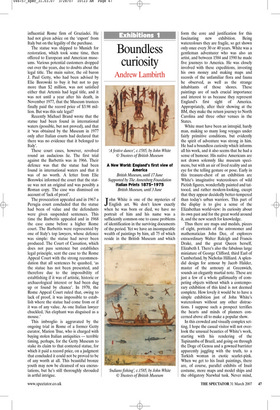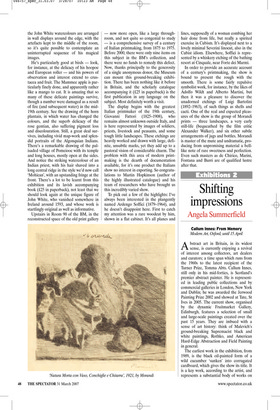Boundless curiosity
Andrew Lambirth
A New World: England’s first view of America British Museum, until 17 June Supported by The Annenberg Foundation Italian Prints 1875–1975 British Museum, until 3 June John White is one of the mysteries of English art. We don’t know exactly when he was born or died, we have no portrait of him and his name was a sufficiently common one to cause problems of identification in the surviving documents of the period. Yet we have an incomparable wealth of paintings by him, all 75 of which reside in the British Museum and which form the core and justification for this fascinating new exhibition. Being watercolours they are fragile, so get shown only once every 30 or 40 years. White was a gentleman adventurer who was also an artist, and between 1584 and 1590 he made five journeys to America. He was closely involved with these expeditions, investing his own money and making maps and records of the unfamiliar flora and fauna he observed, as well as the strange inhabitants of those shores. These paintings are of such crucial importance and interest to us because they represent England’s first sight of America. Appropriately, after their showing at the BM, they make the return journey to North Carolina and three other venues in the States.
White must have been an intrepid, hardy man, making so many long voyages under fairly primitive conditions, but evidently the spirit of adventure was strong in him. He had a boundless curiosity which informs all his work, and it also seems that he had a sense of humour. His native Americans are not drawn solemnly like museum specimens, but with an air of lived reality and an eye for the telling gesture or pose. Early in this treasure-chest of an exhibition are White’s imaginative watercolours of wild Pictish figures, wonderfully painted and tattooed, and rather modern-looking, except that they appear decidedly better-tempered than today’s urban warriors. This part of the display is to give a sense of the Elizabethan world-view: its curiosity about its own past and for the great world around it, and the new search for knowledge.
Thus there are maps and medals, pieces of eight, portraits of the astronomer and mathematician John Dee, of explorers extraordinary Walter Raleigh and Francis Drake, and the great Queen herself, Elizabeth I. There’s also the fabulous large miniature of George Clifford, third Earl of Cumberland, by Nicholas Hilliard. A splendid design for armour by Jacob Halder, master of the armoury at Greenwich, sounds an elegantly martial note. These are just a few of a whole gallimaufry of competing objects without which a contemporary exhibition of this kind is not deemed complete. How lovely it would be to have a simple exhibition just of John White’s watercolours without any other distractions. I suppose such a prospect terrifies the hearts and minds of planners concerned above all to make a popular show.
In this crowded and visually complex setting, I hope the casual visitor will not overlook the unusual beauties of White’s work, starting with his rendering of the Tupinamba of Brazil, and going on through the Doge of Genoa and a gowned barrister apparently juggling with the truth, to a Turkish woman in exotic scarlet-pink. When we get to his Inuit paintings, there are, of course, parallel exhibits of Inuit costume, more maps and model ships and the obligatory Narwhal tusk. Never mind, the John White watercolours are arranged in wall displays around the edge, with the artefacts kept to the middle of the room, so it’s quite possible to contemplate an uninterrupted sequence of his magical images.
He’s particularly good at birds — look, for instance, at the delicacy of his hoopoe and European roller — and his powers of observation and interest extend to crustacea and fruit. The Mammee apple is particularly finely done, and apparently rather like a mango to eat. It is amazing that so many of these delicate paintings survive, though a number were damaged as a result of fire (and subsequent water) in the mid19th century. See the drawing of the horn plantain, in which water has changed the colours, and the superb delicacy of the rose gentian, also suffering pigment loss and discolouration. Still, a great deal survives, including vivid map-work and splendid portraits of the Algonquian Indians. There’s a remarkable drawing of the palisaded village of Pomeiooc with its temple and long houses, mostly open at the sides. And notice the striking watercolour of an Indian priest, with his hair shaved into a long central ridge in the style we’d now call ‘Mohican’, with an upstanding fringe at the front. There’s a lot to be learnt from this exhibition and its lavish accompanying book (£25 in paperback), not least that we should look again at the unique figure of John White, who vanished somewhere in Ireland around 1593, and whose work is startlingly original as well as informative.
Upstairs in Room 90 of the BM, in the reconstructed space of the old print gallery — now more open, like a large throughroom, and not quite so congenial to study — is a comprehensive survey of a century of Italian printmaking, from 1875 to 1975. Before 2000, there were only nine items on this subject in the BM’s collection, and there were no funds to remedy this defect. Now, thanks principally to the generosity of a single anonymous donor, the Museum can mount this ground-breaking exhibition. There has been nothing like it before in Britain, and the scholarly catalogue accompanying it (£25 in paperback) is the first publication in any language on the subject. Most definitely worth a visit.
The display begins with the greatest Italian printmaker of the 19th century, Giovanni Fattori (1825–1908), who remains almost unknown outside Italy, and is here represented by images of soldiers, priests, livestock and peasants, and some tough little landscapes. These etchings are heavily worked and drawn with large, definite, unsubtle marks, yet they add up to a pastoral vision of considerable charm. The problem with this area of modern printmaking is the dearth of documentation available, for it’s one product the Italians show no interest in exporting. So congratulations to Martin Hopkinson (author of the highly illustrated catalogue) and his team of researchers who have brought us this incredibly varied show.
To pick out a few of the highlights: I’ve always been interested in the plangently named Ardengo Soffici (1879–1964), and he doesn’t disappoint here. First to catch my attention was a rare woodcut by him, shown in a flat cabinet. It’s all planes and lines, supposedly of a woman combing her hair done from life, but really a spirited exercise in Cubism. It’s displayed next to a lovely minimal Severini linocut, also in the Cubist idiom. Elsewhere, Soffici is represented by a whiskery etching of the bathing resort at Cinquale, near Forte dei Marmi.
In order to provide an accurate account of a century’s printmaking, the show is bound to present the rough with the smooth. There is some fairly repulsive symbolist work, for instance, by the likes of Adolfo Wildt and Alberto Martini, but then it was a pleasure to discover the unadorned etchings of Luigi Bartolini (1892–1963), of such things as shells and cacti. One of the real and expected pleasures of the show is the group of Morandi prints — three landscapes, a very early still-life (bequeathed by the film critic Alexander Walker), and six other subtle arrangements of jugs and bottles. Morandi is master of the mute and undramatic, producing from unpromising material a belllike note of rare sweetness and perfection. Even such masters as de Chirico, Marini, Fontana and Burri are of qualified lustre after that.











































































 Previous page
Previous page